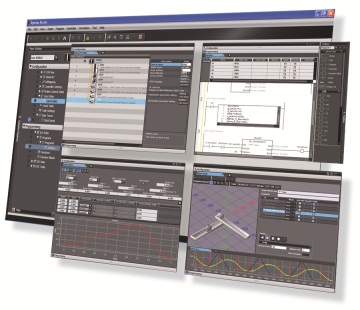
All-in-One Automation
By Mike McLeod
Motion Control OmronOmron’s Machine Automation Controller integrates multiple controllers while maintaining high performance.
In November, Omron Industrial Automation announced what the company billed as a new category in automation control, the Machine Automation Controller (MAC). While similar to established categories (e.g. PLC, PAC and Industrial PC), the company says the MAC incorporates aspects of each but combines and coordinates the various functions to create an architecture unmatched in the industry.
To fill this newly created category, Omron unveiled its Sysmac NJ-Series MAC, a high-end controller that integrates and synchronizes motion, logic and vision in one unit. Like a PLC, the NJ-Series is “hardened” for industrial environments but houses a fanless processor at its core like an Industrial PC.
Comparatively, says Omron commercial engineer for PLCs and IO, Johnston Hall, the NJ-Series MAC is most like an enhanced version of the Programmable Automation Controller (PAC); the MAC handles the same functions but can coordinate motion, logic and vision synchronously and at an exceptionally high speed.
“With a PAC, you add software to a controller for all the different functions, but the different software still has to ‘talk’ to each other and, therefore, aren’t really synchronized,” he says. “With the MAC, the three processes are unified and synchronized; that way there is no time loss.”
According to Omron, the NJ-Series updates motion, network and user application updates in the same scan to ensure synchronicity. In addition, it handles more axes (16, 32 or 64) than typical controllers but its response time remains very fast—1ms for applications up to 32 axes and 2ms for 64 axes.
Part of that speed is due to the NJ-Series’ hardware. The controller runs a 1.66 MHz dual core Intel Atom processor running an embedded real time operating system (RTOS) in non-volatile RAM.

Like its hardware counterpart, Sysmac Studio combines an IDE with configuration, monitoring and simulation.
To communicate less time sensitive data, the Omron’s MAC also “speaks” the popular EtherNet/IP protocol, facilitating remote access; interface with HMIs and SCADA software; and tie the controller into the larger peer-to-peer network.
EtherNet/IP also serves as the communication conduit to the last piece of Omron’s MAC puzzle: Sysmac Studio, the company’s software that serves as an IDE programming environment as well as for configuration, simulation and monitoring. Compliant with the IEC 61131-3 standard, Sysmac Studio supports ladder logic, structured text and function block programming languages. The package also includes a CAM editor for programming of motion profiles and a 3D sequence and motion simulation environment to assist debugging.
“Customers told us they were having trouble integrating the three technologies as well as maintaining machines because there were too many software packages and too many cables,” Hall says. “Now, with the MAC, a user can program, back up and tune from a single point.”
www.omron247.com
